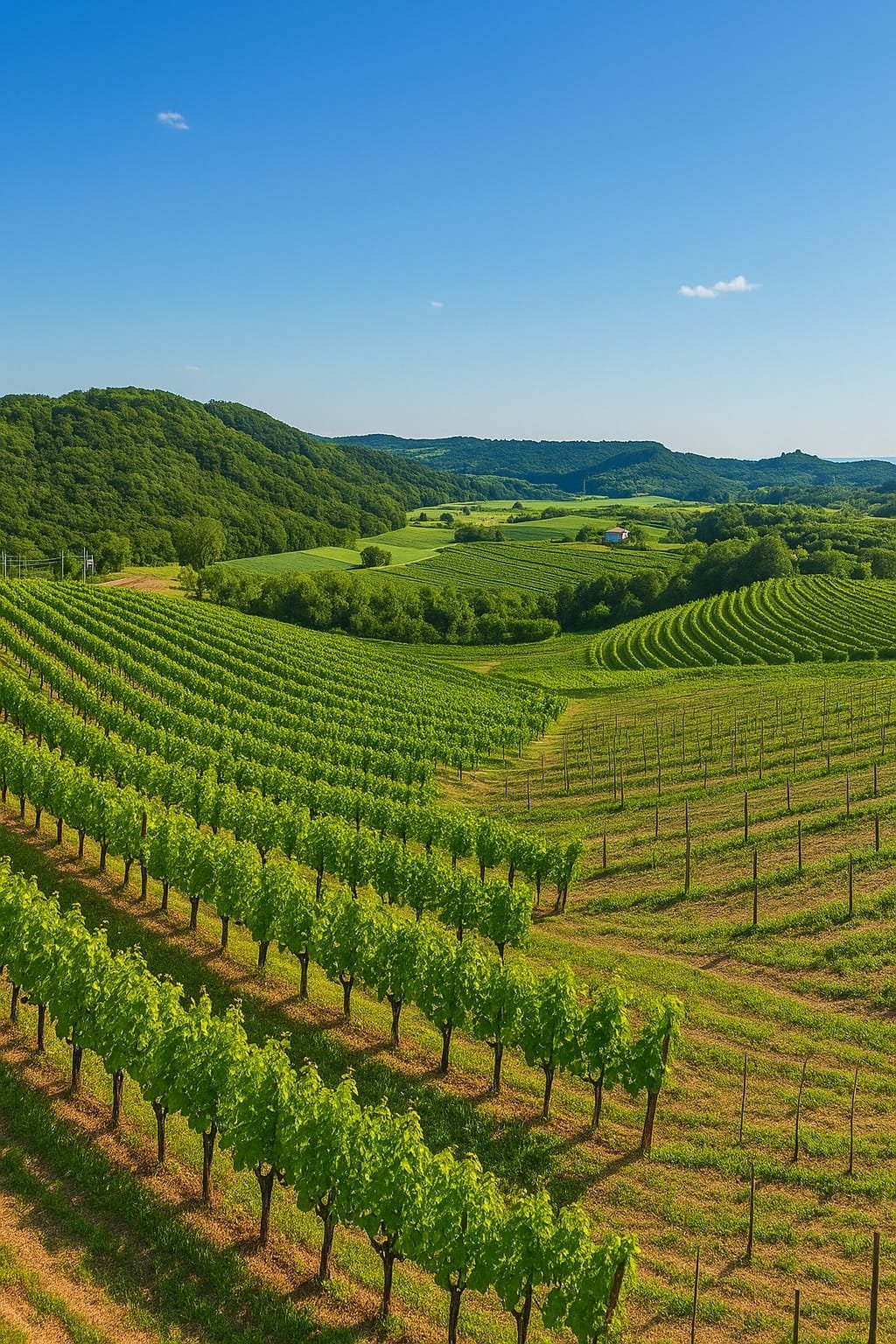Collio Goriziano
Nestled in the northeastern corner of Italy, along the Slovenian border, lies Collio Goriziano—also known simply as Collio DOC. This small yet prestigious wine region in Friuli-Venezia Giulia is renowned for its hillside vineyards, mineral-rich soils, and a winemaking tradition that bridges ancient heritage with modern innovation.
A Historic Crossroads of Culture and Viticulture
The name "Collio" derives from the Italian word colli, meaning "hillsides," aptly describing the region's undulating terrain. Viticulture in Collio dates back to Roman times, with the first written documentation of the Ribolla Gialla grape appearing in 1289. Over the centuries, the region's wines were highly prized, even being sought after by European royalty. However, the phylloxera epidemic of the 19th century devastated vineyards, leading many growers to replant with international varieties like Merlot and Sauvignon Blanc. The tumultuous events of the 20th century, including both World Wars, further impacted the region. Collio was on the front lines during World War I, and many of its vineyards were destroyed. Post-war reconstruction efforts revitalized viticulture, and in 1968, Collio was granted Denominazione di Origine Controllata (DOC) status, recognizing its commitment to quality winemaking.
Collio's location at the crossroads of Latin, Slavic, and Germanic cultures has profoundly influenced its winemaking traditions. The region's history as part of the Austro-Hungarian Empire, followed by its incorporation into Italy after World War I, and the subsequent border changes post-World War II, have all left their mark. Today, the region's vineyards extend into Slovenia, where they are known as Brda, reflecting the shared heritage and collaborative spirit between the two countries.
The unique microclimate of Collio, influenced by the Julian Alps to the north and the Adriatic Sea to the south, provides ideal conditions for viticulture. The region's signature ponca soil—a mix of calcareous marl and flysch sandstone—imparts a distinctive minerality to the wines, contributing to their complexity and aging potential.
A White Wine Powerhouse
Collio DOC is predominantly a white wine region, with over 85% of its production dedicated to white grape varieties. The leading styles produced, in descending order, are Pinot Grigio, Sauvignon, Ribolla Gialla, and Friulano, collectively representing three-quarters of the DOC’s production. These wines are celebrated for their freshness, body, and longevity, often exhibiting a balance of fruit and minerality that reflects the region's unique terroir.
Ribolla Gialla, an indigenous variety, is known for its lively acidity and fresh, citrusy flavors. Friulano offers a richer, creamier profile, often finishing with a touch of bitter almond. International varieties like Pinot Grigio and Sauvignon Blanc also thrive here, developing depth and minerality from Collio’s terroir.
The region's white wines are typically fermented in stainless steel tanks to preserve their fresh fruit and varietal characteristics. Winemakers often employ modern techniques, such as cold fermentation and the use of refrigerated fermentation tanks, to achieve this goal. While oak influence is not widely used, some producers experiment with its use to add complexity to their wines.
Red Wines and Emerging Orange Wines
While white wines dominate, Collio also produces notable red wines under the Collio Rosso designation, typically blends of Merlot, Cabernet Franc, and Cabernet Sauvignon. These red wines are known for their structure and finesse, often aged in oak to enhance their complexity and aging potential.
In recent years, the region has gained recognition for its orange wines—white wines made with extended skin contact. Pioneering producers like Joško Gravner and Stanko Radikon have led this movement, reviving traditional methods of skin fermentation that had fallen out of favor in the 20th century. These wines, often aged in amphorae, are celebrated for their depth, complexity, and connection to ancestral winemaking practices.
As of 2025, orange wines have been officially integrated into Collio DOC regulations, marking a significant development in the region's winemaking landscape. This move acknowledges the historical significance and growing popularity of these wines, further solidifying Collio's reputation as a hub of innovation and tradition in Italian winemaking.
Terroir and Winemaking Techniques
Collio's vineyards benefit from a unique microclimate, with the Julian Alps providing shelter from northern winds and the Adriatic Sea offering moderating breezes. The soil, known locally as ponca, is a mix of calcareous marl and flysch sandstone, contributing to the wines' distinctive minerality.
Winemakers in the region often employ modern techniques, such as cold fermentation and the use of refrigerated fermentation tanks, to preserve the fresh fruit and varietal characteristics of the grapes. The objective of most Collio Goriziano winemakers is to maximize the fresh fruit and pure varietal characteristic of the grape. To that extent, oak influence is not widely used in this region, though some winemakers are experimenting with its use and different blends of grape varieties to produce more complex wine.
The combination of Collio's unique terroir and innovative winemaking techniques results in wines that are both expressive and reflective of their origin. Whether it's the crisp, aromatic whites or the structured, age-worthy reds, Collio's wines offer a diverse and compelling tasting experience.
A Community of Dedicated Winemakers
Collio is home to approximately 300 growers and producers, collectively farming around 1,300 hectares and producing about 7 million bottles annually. Many of these are family-run estates that emphasize sustainable practices and a deep connection to the land. Producers like Gradis'ciutta and Russiz Superiore exemplify this commitment, offering wines that reflect both tradition and innovation.
Winemakers in Collio are increasingly adopting organic and biodynamic farming practices, recognizing the importance of environmental stewardship in preserving the region's unique terroir. This dedication to sustainability not only benefits the environment but also enhances the quality and authenticity of the wines produced.
The collaborative spirit among Collio's winemakers fosters a sense of community and shared purpose. Through cooperative efforts and knowledge sharing, they continue to elevate the region's reputation on the international stage, ensuring that Collio's wines are recognized and appreciated by wine enthusiasts around the world.
Visiting Collio: A Wine Lover's Destination
For those seeking an immersive wine experience, Collio offers picturesque landscapes, historic villages, and a warm, welcoming community. Visitors can explore the region's vineyards, participate in tastings, and learn about the unique winemaking processes that define Collio DOC. Whether you're a seasoned oenophile or a curious traveler, Collio provides a rich tapestry of flavors, history, and culture waiting to be discovered.
In summary, Collio Goriziano stands as a testament to Italy's diverse and dynamic wine heritage. Its dedication to quality, innovation, and tradition makes it a region worth exploring for anyone passionate about wine.

